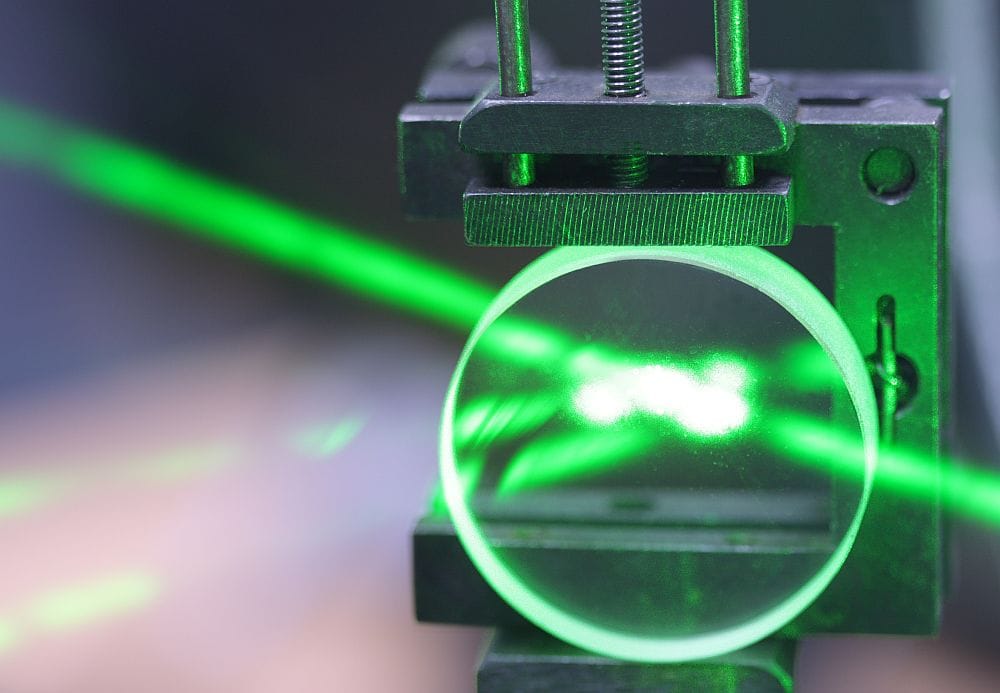
[Image above] Diagrams showing the two different atomic structural configurations of a new shape-memory zirconia. An external trigger, such as a temperature change, can cause a shift between the two configurations. Credit: Edward Pang, Massachusetts Institute of Technology
Though ceramics are traditionally valued for their hardness, it comes at the cost of a low fracture toughness. The same atomic bonds that endow ceramics with strength also makes them unable to plastically deform the way metals and plastics do.
In recent decades, researchers have actively explored ways to overcome a ceramic’s brittleness while retaining its strength and thermal/chemical resistance. The development of shape-memory ceramics is one fruitful example of this research.
Shape-memory materials are materials that can recover their initial shape under the influence of external stimuli, such as temperature, light, moisture, acidity, or electricity. Certain metal alloys were the first materials identified to exhibit the shape-memory effect, and researchers have identified a variety of shape-memory polymers and polymer composites that exhibit the effect as well.
The shape-memory effect is based on the material undergoing a phase change when exposed to external stimuli. In the case of shape-memory polymers, the change between a hard phase to soft phase can be achieved through a variety of physical means due to the intrinsic elasticity of polymeric networks. For shape-memory alloys, the effect stems from the material having two stable crystal structures: a high temperature-favored austenitic phase and a low temperature-favored (and “yieldable”) martensitic phase.
Like alloys, ceramics consist of a crystalline structure with different stable solid phases. This similarity between alloys and ceramics, particularly zirconia-based ceramics, has led to some success in developing shape-memory ceramics by applying the same general strategies used for alloys.
For example, when alloys and ceramics undergo transformation from one solid phase to another, they can experience a stressed transition layer separating the two phases. This strain on the material’s lattice can lead to deleterious bond-breaking events.
To lessen this strain, researchers will try to improve the geometric compatibility of the different phases, such as by doping the material. As a result, the strain between the transforming region and surrounding untransformed matrix is reduced.
This approach is highly successful for improving the phase transformation in metals. Some shape-memory alloys can undergo millions of transformation cycles without failure. However, even when a shape-memory ceramic’s geometric compatibility is improved, it still often experiences cracking after just a few dozen transformation cycles. (Or explosive results if the incorrect dopants are used.)
In a recent paper, researchers from Massachusetts Institute of Technology looked to improve the cyclability of shape-memory zirconia ceramics with the help of a multimode modeling approach.
As they explain in the paper, lattice compatibility by itself does not dictate the success of the phase transformation. Other factors, such as friction at the moving transformation front, play critical roles.
So, they augmented the traditional lattice engineering approach with several modern tools—computational thermodynamics, phase transformation physics, crystallographic calculations, and machine learning—to account for these additional constraints.
This multimode modeling approach resulted in a new zirconia composition (ZrO2–TiO2–[AlO1.5– CrO1.5]) that displayed properties on par with those of some shape-memory alloys.
For example, this shape-memory zirconia displayed record low hysteresis of 15 K (“hysteresis” refers to the difference in transformation temperature on heating and cooling). This value is about ten times less compared to typical hysteresis values and approximately five times less than the best values reported so far.
“This record low hysteresis is also achieved in a sample that transforms fully between its monoclinic and tetragonal phases, which is a testament to the successful simultaneous reduction of volume mismatch,” the researchers write.
Additionally, lattice parameter measurements revealed this zirconia undergoes large transformation strains of more than 10% in conjunction with the low observed hysteresis. This finding indicates “the improved hysteresis is not achieved by minimizing the transformation strains but rather by making them more crystallographically compatible,” the researchers add.
They also note that the discovery of this new shape-memory zirconia is based solely on varying chemistry while maintaining the same processing conditions.
“Because hysteresis can also be affected by processing conditions and associated microstructural changes … the present compositional optimization can now be combined with process optimization to achieve further reductions in hysteresis,” they write.
There is great potential for the new shape-memory ceramic in broad applications, such as in actuators that direct airflow inside a jet engine. As an MIT press release explains, “While the overall environment there is hot, there are various channels of airflow being controlled, so those flows could be used to trigger a shape-memory ceramic by directing cooler or hotter air on the device as needed.”
The researchers plan to continue exploring the new material, finding ways to produce it in bigger batches and more complex shapes, as well as testing its ability to withstand many cycles of transformation.
The paper, published in Nature, is “Low-hysteresis shape-memory ceramics designed by multimode modelling” (DOI: 10.1038/s41586-022-05210-1).
Author
Laurel Sheppard
CTT Categories
- Material Innovations
- Modeling & Simulation


